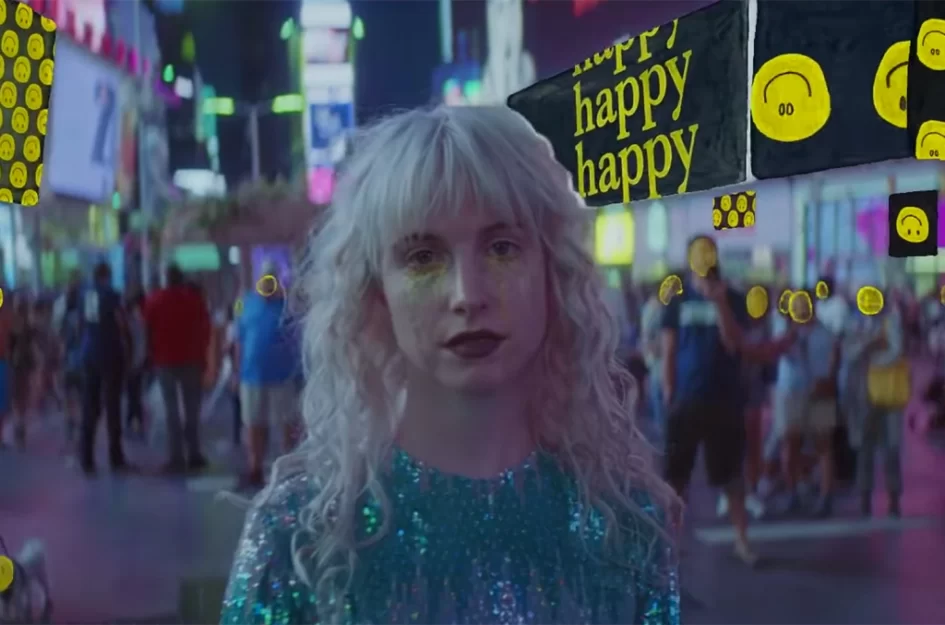In many cases, the performance and delivery of music crafts rhetoric in ways that lyrics can not exclusively accomplish. This can be seen with Paramore’s “Fake Happy”, in both the official music video and lead singer Hayley Williams’ performance of the song at a concert in June of 2018.
About a year after “Fake Happy” was released, Paramore performed a show in Syracuse, NY. Before getting into the song, Williams interacts with the crowd to gauge how they are feeling. At one point, you can hear a man in the crowd ask her how she was feeling, to which she replied “I feel real happy”, with a smile. Some may view this as an extension of the song, faking happiness for the sake of others. Even though her smile looks genuine, the fact that she is about to perform “Fake Happy” changes the audience’s perspective about what is real and what is fake. Williams goes on to deliver an energetic performance of the song, dancing around stage and interacting with the audience. Again, if she were delivering different lyrics, this performance could be seen as lively and upbeat. There is a part of “Fake Happy” that explicitly says, “You see it’s easy when I’m stomping on a beat”, referring to Williams’ fraudulent happiness. In the case of the Syracuse concert, she is literally stomping on a beat. Because the song is about being really good at masking true emotions, skepticism is created.
In the “Fake Happy” official music video, Williams starts off by looking very confused and out of touch with reality. She rubs her face, blinks slowly, and then turns to the camera to make eye contact with the audience members. The camera blurs and zooms in and out while Williams surveys her surroundings. Next, the video transitions to Williams featured in a digitalized world where everyone, except her, has a yellow upside-down smiley face covering their true identity. These people are going about their daily activities; some exercising, some walking home from work, some admiring the sights of Times Square. Williams dances around people, twirling, cheering others on, and skipping. While these seem like very happy activities, her face is not revealed until the very end when she turns to the camera, smile fading, with tear stains on her cheeks. The final scene of the video is Williams holding up a holographic upside-down smiley face that all of the other people had to herself, to prove that she is no better than the rest of them.
This video uses visuals described in the lyrics to emphasize the point that so many people are putting on a fake face to the world in order to appear happy. The fact that the smiley faces are upside down is themselves a comment on being “anti-happy”. Also, seeing Williams crying at the end of the music video and succumbing to the “peer pressure” of wearing a fake smile further demonstrates how difficult it is to break free from these outside influences.

November 6, 2022 at 1:42 pm
Megan,
This is a very thought-provoking post, and I really like the opening sentence, “In many cases, the performance and delivery of music crafts rhetoric in ways that lyrics can not exclusively accomplish.” Just great. That sentence needs to find its way into your podcast.
To be honest I’m going back and forth about what I think about your discussion of when Paramore says, “I’m feeling good, thanks for asking” with a smile on her face. My ambivalence comes with the idea that just because an artist wrote a song years before about not necessarily being happy doesn’t necessarily mean that she still feels fake happy when performing it at that particular moment. Another interpretation is that one can feel fake happy at one time, work through it, and get to the point when asked how you’re feeling you can give an authentic answer, Yes. As she says just before she is asked, you have to savor those moments of happiness. Use them and remember them during those moments when not so happy.
Now, I don’t know enough about the song or Paramore to say whether or not it is in performing that she become truly happy or fake happy, or if she is someone who would present fake happiness in that venue when asked directly (quite surprised to be asked, too) if she is happy.
But what seems most empowering about that video and performance is how she connects to the audience, and fully understands that people in that space have experienced the feelings articulated in that song. By sharing her song and her happiness she is empowering others to feel okay about feeling (or having felt) both emotions.
As you write, “performance and delivery of music craft rhetoric” and responses that take time to interpret. Thanks for asking me to start to do that…
Looking forward to your podcast!
Bill